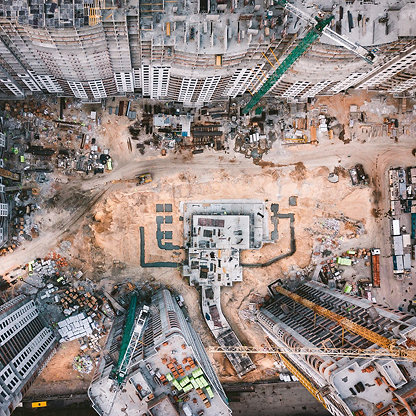The building sector holds a pivotal role in the European Union's ambitious climate and energy strategies. In a recent webinar, a panel of experts discussed the latest revision of the Energy Performance of Buildings Directive (EPBD) and its impacts in the building sector.
EPBD objectives
Today nearly 75% of EU building stock does not meet energy efficiency standards. This presents a pressing issue given that 85% of these structures are predicted to be still operational in 2050, explains webinar moderator Fausta Todhe, EU Public Affairs Manager at RICS. A further concern is the low rate of building renovation in the region, which stands at 1% per annum.
The objectives of the EPBD cover not only energy performance but also environmental performance and social impacts, outlines Jonathan Martins MRICS, Manager - Sustainability Strategic Consulting at Ramboll Management Consulting. The EPBD’s goals include accelerating renovation rates, and through construction and renovation creating jobs and improving skills across the EU. The EPBD recognises that lower energy demand is key to reducing greenhouse gas emissions, hence the need to improve the energy efficiency of buildings, he explains.
Among the requirements set out in the proposed revision of the EPBD, explains Fausta, is that as of 2028 all new buildings must be zero-emission. For new public infrastructure the date is 2026. The EPBD also mandates a minimum energy performance for existing buildings. For residential buildings, this is class E by 2030 and class D by 2033, while for non-residential and public buildings the deadlines to achieve these ratings are 2027 and 2030 respectively.
Defining net zero
With the deadline for new commercial buildings just over four years away, ‘one of the biggest challenges in terms of implementation is that the definition of zero emission is not precise enough and could allow for exemptions’, says Aneta Rusiniak MRICS, Director, ESG for Real Estate - Europe at Invesco Real Estate. For example, she says, protected buildings and secondary residences are excluded. This can create ways to circumvent the Directive, especially when Member States are free to decide how they define officially protected buildings. Aneta also points out that nearly-zero-emission building standards already exist. However, because there are so many different interpretations and definitions across Europe, it is difficult to manage and know the actual thresholds per country. The Directive provides a huge opportunity to remedy this through standardisation, harmonisation, rescaling of Energy Performance Certificates (EPCs). The EPBD includes a template for EPCs with a minimum number of common indicators on energy and greenhouse gas emissions. This is complemented with a number of voluntary ones, such as on charging points, indoor air quality and global warming potential based on the building's life-cycle carbon emissions.
The principle of subsidiarity seeks to safeguard the decision-making ability of Member States and authorises EU intervention only when a Member State cannot sufficiently achieve an objective. This principle could make it harder to achieve a European framework that can be universally applied, cautions Olivier Elamine, CEO at alstria office REIT-AG.
“Renovation rates have stagnated at about 1% and we need to go towards 2–3% per annum. That is a massive challenge.”
Jonathan Martins, MRICS
Manager - Sustainability Strategic Consulting, Ramboll Management Consulting
Renovation challenges
‘Good renovation is a deep renovation that really transforms the building and significantly improves the energy performance of that building, but is very expensive’, says Jonathan. ‘Renovation rates have stagnated at about 1% and we need to go towards 2–3% per annum. That is a massive challenge’, he says. Jonathan also raises the question of what will happen to buildings that are too expensive to renovate, of which there are many in non-prime locations across Europe.
‘We have the money to renovate, that's not the problem ... the problem is there's nobody to do the renovation. And one of the reasons why there's no workforce is because we have too much new construction happening’, says Olivier. He believes that unless the issue of human resources is addressed, it is unlikely that significant renovation will occur because the main constraint is not always money. While there is still a need for new housing, he argues there is probably less of a need to build new for-profit commercial buildings at the current rate. He also points out that constructing new buildings, where you start from a blank page, is less complex than renovation, and advocates providing incentives to encourage more construction companies to move into renovation.
Tackling embodied carbon
The EPBD is proposing to incorporate embodied carbon within EPCs, extending the scope of EPCs to encompass the whole life cycle, says, Aneta. It is an important step towards shifting the thinking about building needs towards modernisation rather than new buildings, but it requires a lot of education, she says. In future revisions of the EPBD, she would like to see a link between embodied carbon and energy performance requirements. This would enable us to draw insights from sustainable innovations, make more informed material choices and build a more compelling case for renovation as opposed to new construction, she explains.
“We have the money to renovate, that's not the problem ... the problem is there's nobody to do the renovation.”
Olivier Elamine
CEO, alstria office REIT-AG
Upskilling
The need to train personnel in new techniques, technologies and building renovation skills is essential, says Jonathan. ‘We will not achieve our targets without getting our workforce up to speed’, he warns. Much of the construction sector consists of small companies that lack the resources and capacity of large companies. It is therefore vital that governments increase training and upskilling opportunities, he says. This is particularly important given the EPBD’s instruction that renovation is carried out according to state-of-the-art practices. Without adequate training, when complex technology is introduced into a building, it is often not implemented correctly and is often not usable as first intended, adds Olivier.
Consumer support
A network of experts to provide renovation information support to consumers is being called for by the EPBD, says Jonathan. There is an important distinction between homeowners and professional investors or owners with capital expenditure plans. The renovation passport being proposed by the EU will be very helpful for homeowners in calculating renovation costs, says Olivier.
The EPBD is still a work in progress and evolving, but Olivier stresses the need for action on the ground now, otherwise we will not be able to deliver on the EU's 2030 and 2050 decarbonisation objectives.
How will the adoption of the EPBD affect Europe’s real estate industry? The forthcoming measures of the Directive, particularly in relation to national averages, will demand meticulous data gathering to ascertain the precise sustainability performance standards mandated by the Directive.
In this exclusive webinar, hosted in collaboration with INREV, EPRA, and RICS, we unveil the working group on the Energy Performance of Buildings Directive (EPBD), discuss the interplay of energy efficiency, carbon requirements, and the legislative impact of the Directive, what it means for the industry, and how real estate can thrive under such obligations.




